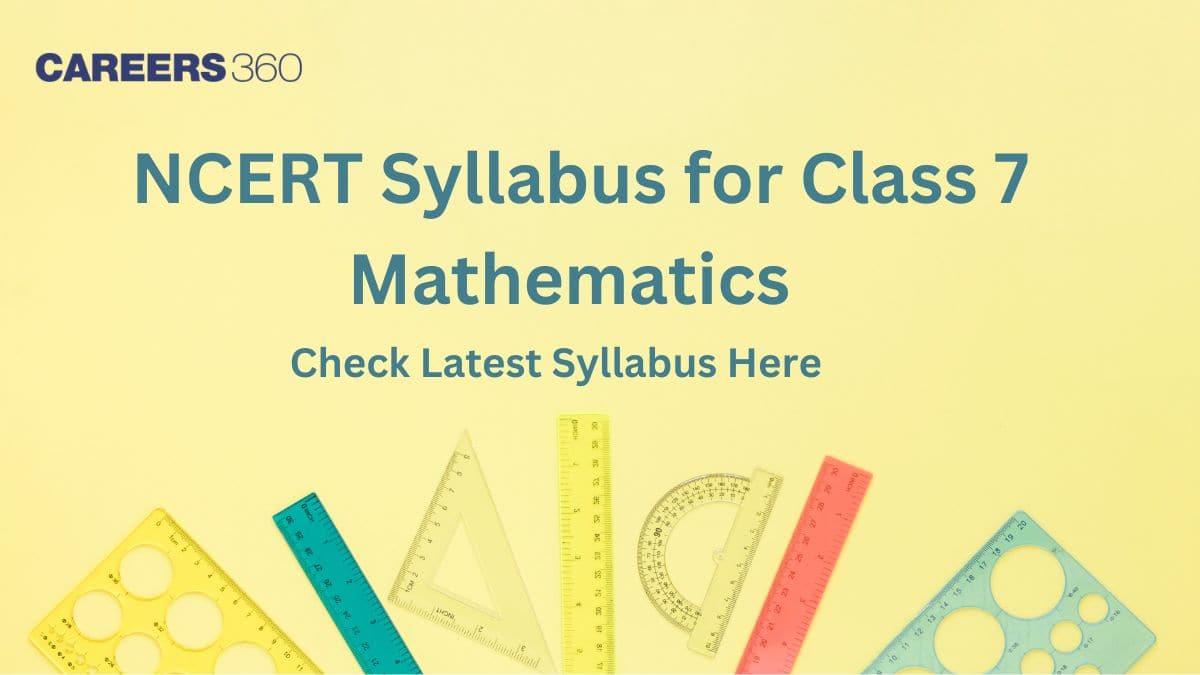Aakash Repeater Courses
ApplyTake Aakash iACST and get instant scholarship on coaching programs.
A syllabus is your roadmap to success; without a proper syllabus, learning becomes uncertain and directionless. Based on the latest CBSE guidelines, the NCERT Syllabus for Class 7 Maths has been created to help the students in their mathematical journey. The syllabus includes some key mathematical concepts like exact and approximate values, simple and complex expressions, the decimal system, parallel and intersecting lines, etc. At first glance, the Class 7 maths syllabus may appear large and complex to the students, but it can be easily understood with proper guidance. It is always advised to learn the syllabus first before you begin your studies. For PDFs, Notes, and Solutions of other study materials, click here: NCERT.

This article will provide a chapter-wise detailed analysis of the Class 7 maths syllabus 2025-26, helping the students and teachers alike to prepare for the studies. The NCERT Syllabus are created in such a way that it plays an important role in developing the problem-solving, analytical, and logical skills of the students. With the proper knowledge about the Class 7 NCERT maths syllabus, students can be well prepared for their exams. Students can also refer to the NCERT Books according to the latest syllabus.
There are a total of 8 chapters in the Class 7 Maths NCERT Syllabus 2025-26. The following includes subtopics for each chapter in Class 7 NCERT Maths.
A Lakh Varieties!
Reading and Writing Numbers
Land of Tens
Of Crores and Crores!
Exact and Approximate Values
Patterns in Products
Did You Ever Wonder…?
Simple Expressions
Reading and Evaluating Complex Expressions
Brackets in Expressions
Terms in Expression
Swapping and Grouping
Swapping the Order of Things in Everyday Life
Removing Brackets
The Need for Smaller Units
A Tenth Part
A Hundredth Part
Decimal Place Value
Notation, Writing and Reading of Decimal Numbers
Units of Measurement
Locating and Comparing Decimals
Addition and Subtraction of Decimals
More on the Decimal System
The Notion of Letter-Numbers
Revisiting Arithmetic Expressions
Omission of the Multiplication Symbol in Algebraic Expressions
Simplification of Algebraic Expressions
Formula Detective
Algebraic Expressions to Describe Patterns
Patterns in a Calendar
Matchstick Patterns
Across the Line
Perpendicular Lines
Between Lines
Parallel and Perpendicular Lines in Paper Folding
Transversals
Corresponding Angles
Alternate Angles
Consecutive Angle
Parallel Illusions
Numbers Tell us Things
Picking Parity
Some Explorations in Grids
3 × 3 & 4 × 4 Magic Square
Nature’s Favourite Sequence: The Virahāṅka Fibonacci Numbers!
Digits in Disguise
Triangles
Equilateral Triangles
Constructing a Triangle When its Sides are Given
Triangle Inequality
Visualising the Construction of Circles
Construction of Triangles When Some Sides and Angles are Given
Angle Sum Property
Exterior Angles Property
Constructions Related to Altitudes of Triangles
Types of Triangles
Multiplication of Fractions
Connection between the Area of a Rectangle and Fraction Multiplication
Simplifying to Lowest Form
Order of Multiplication
Division of Fractions
Some Problems Involving Fractions
At Careers360, the subject matter experts have created a PDF version of the latest NCERT Class 7 Maths Syllabus. You can simply click on the link below to directly download the PDF file and access it offline as you like:
Download NCERT syllabus for class 7 Maths 2025-26 PDF
The syllabus is made keeping in mind the three important aspects of mathematics, such as arithmetic, algebra, and geometry. All the chapters are distributed in these three major parts. The concepts are presented in a way that students can easily relate them to their knowledge from the previous class. Also, the real-world applications of each chapter are highlighted to help develop the critical thinking and problem-solving skills of the students.
The 2025-26 syllabus is updated according to the National Education Policy (NEP), 2020. The major changes or highlight points of the syllabus are:
For those of you who are wondering which chapters are removed or deleted from the previous syllabus. Given below are the topics which are no longer present in the latest syllabus:
There is no fixed pattern for how the marks are going to be distributed according to the latest Class 7 maths syllabus, but most of the time, CBSE follows a four-section format, which is given below:
For class 7th, the NCERT textbooks are enough to study from. But if anyone is looking for JEE or NEET in the future, additional study material will help to achieve the target. There are many reference books for class 7 CBSE Maths available that provide a chapter-wise question bank with solutions, sample question papers, and Higher Order Thinking Problems (HOTs). Here are some of the best reference books for Class 7 Maths CBSE:
These will provide comprehensive practice material for every chapter and are prepared by experienced teachers who are experts in their field and have translated their knowledge and experience into making important questions from every chapter in order to facilitate wholesome learning of every concept.
Also check: NCERT books for Class 7
The students can also go through the other class 7 syllabus of the other subjects using the links given below. This can help the students perform well in the other subjects as well.
The latest 2025-26 NCERT textbook for Class 7 Maths contains a total of 8 chapters, including arithmetic expressions, intersecting and parallel lines, and working with fractions, among others.
Chapters which are removed or deleted from the previous syllabus, i.e. which are no longer present in the latest syllabus of NCERT class 7 maths:
The NCERT Class 7 Maths exercises include a wide variety of question types to build a strong conceptual clarity and enhance the problem-solving skills of the students. These types mainly include numerical problems, worded problems, fill in the blanks, true-false reasoning, multiple-choice questions, etc.
Yes, as per the latest NCERT syllabus, class 7 maths does include topics from geometry and algebra. In geometry, we have intersecting and parallel lines and a tale of three intersecting lines, while in the Algebra section, we have working with fractions, arithmetic expressions, and a peek beyond the point, etc.
Yes, the NCERT books are well-structured, aligned with the latest syllabus and provide a solid foundation. For extra practice, you can use exemplar problems and previous year questions.
Exam Date:22 July,2025 - 29 July,2025
Exam Date:22 July,2025 - 28 July,2025

Take Aakash iACST and get instant scholarship on coaching programs.

This ebook serves as a valuable study guide for NEET 2025 exam.

This e-book offers NEET PYQ and serves as an indispensable NEET study material.

As per latest syllabus. Physics formulas, equations, & laws of class 11 & 12th chapters
As per latest syllabus. Chemistry formulas, equations, & laws of class 11 & 12th chapters
As per latest 2024 syllabus. Study 40% syllabus and score upto 100% marks in JEE